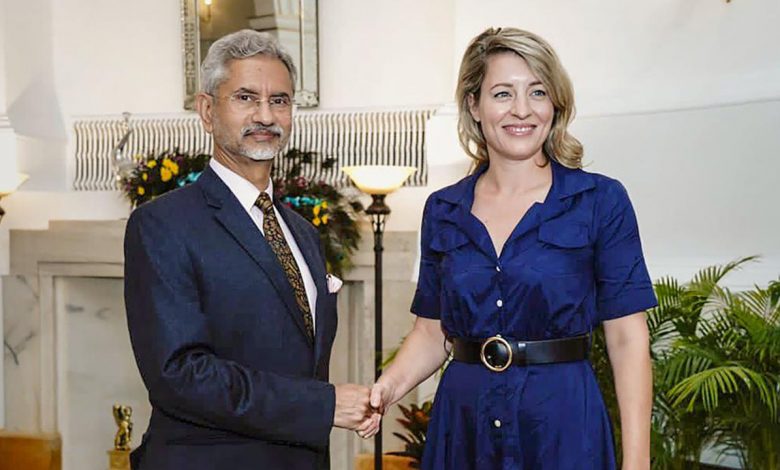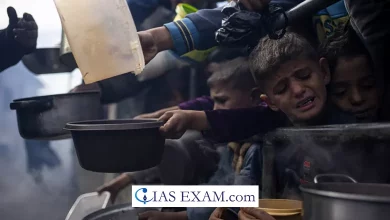Daily Current Affairs for UPSC
India-Canada strategic Dialogue
Syllabus- International Relations [GS Paper-2]

Context– Prior to the G20 Foreign Ministers meeting in March in New Delhi, the bilateral meeting of the foreign ministers of India and Canada, dubbed the “India-Canada Strategic Dialogue,” recently took place.
Key Highlights
- Given the shared objective of a free, open, and inclusive Indo-Pacific, India welcomed Canada’s release of its Indo-Pacific Strategy.
- What were the Meeting’s High Points?
- The Ministers talked about expanding our close inter-ethnic ties, promoting security cooperation, facilitating migration and mobility, and deepening our economic collaboration.
- India is a crucial partner for Canada in the Indo-Pacific, according to the Canadian FM. In exchange, Canada can be a dependable source of vital minerals, a powerful ally in the transition to a greener economy, and a sizable investor.
- Objectivity of the Meeting
- After a freeze between 2020 and 2022, the Canadian FM’s visit is anticipated to open the door for a sustained reset in India-Canada relations.
- The freeze was sparked by a number of issues, including attacks on Canadian Khalistani groups’ targets of Indian ancestry, Canadian remarks regarding Indian farmer demonstrations, and India’s suspension of diplomatic discussions in retaliation.
- When Canada allowed a Khalistani independence “referendum” in 2022, New Delhi complained and retaliated with a travel warning that cautioned against hate crimes in Canada.
- Both nations welcome the “Early Progress Trade Agreement” (EPTA) as a first step towards the “Comprehensive Economic Partnership Agreement” (CEPA), in addition to attracting investment from Canadian capital.
- None of the official statements addressed the issue of Khalistani activities in Canada, which has contributed to the strained relationship between India and Canada.
- India’s strategic importance will only grow as the country’s economy grows, giving Canada and India more chances to strengthen their relationship.
- Both nations have a suspicion of China and want to strengthen their supply chains, expand trade ties, and encourage more people to move between them.
What is the Indo-Pacific Policy of Canada?
- Canada unveiled a new Indo-Pacific strategy that focuses on the following four areas: ASEAN, China, India, Japan, Korea, and the North Pacific
- Canada has the largest diaspora, with 60% of international students and one in five Canadians having family ties to the Indo-Pacific region.
- The strategy praises India’s shared tradition of democracy and pluralism while speaking forcefully about China’s challenge to the international rules-based order and human rights.
- However, Canada acknowledges that China is its primary export destination and that cooperation with China is necessary on health and climate change issues.
Funding:
- Over the course of five years, Canada’s strategy calls for a funding commitment of $1.7 billion for infrastructure projects, increased military presence, and increased participation in regional military exercises.
Objectives:
- Bolster stability, resilience, and peace.
- Increase the resilience of supply chains, investments, and trade.
- Connect people and invest in them.
- Create a future that is green and sustainable.
- Be a partner in the Indo-Pacific that is involved and active.
How are relations between India and Canada?
- Political:
-
-
- India and Canada have similar structures and procedures for their parliaments. Mr. Raj Saini, a member of the House of Commons, will serve as the Chair of the Canada-India Parliamentary Association following the general election in October 2019.
- The Canadian High Commission in New Delhi represents Canada in India.
- India has consulates in Toronto and Vancouver as well as a High Commission in Ottawa.
-
- Economic:
-
-
- In 2020, trade between India and Canada will amount to USD 6.4 billion. India ranked as Canada’s 13th largest trading partner and 14th largest export market in 2021.
- More than 1,000 Canadian businesses are actively pursuing business in the Indian market, and over 400 Canadian businesses have a presence in India.
- Indian businesses operate in Canada’s software, steel, natural resources, banking, and information technology sectors.
- Pharma, iron and steel, chemicals, gems and jewelry, nuclear reactors, and boilers are among the goods that India exports to Canada.
- Uranium, natural gas, oil, coal, minerals, and cutting-edge hydropower, mining, renewable energy, and nuclear energy technologies are among the most abundant resources in Canada.
-
- Technologies and Sciences:
-
-
- Promotion of industrial R&D and the creation of new IP (intellectual property) processes, prototypes, or products has been the primary focus.
- Under the IC-IMPACTS program, the Department of Biotechnology conducts joint research projects in agri-biotech, waste management, and health care.
- The first and only Canada-India research center of excellence is IC-IMPACTS, which stands for the India-Canada Centre for Innovative Multidisciplinary Partnerships to Accelerate Community Transformation and Sustainability.
- A program for scientific research on Cold Climate (Arctic) Studies has been launched by the Department of Earth Science and Polar Canada.
-
- Space:
-
-
- In the area of space exploration and utilization, MOUs have been signed by ISRO and the Canadian Space Agency (CSA).
- -A number of nanosatellites have been launched from Canada by ANTRIX, ISRO’s commercial arm.
- The Canadian first LEO (Low Earth Orbit) satellite was also launched by ISRO’s 100th satellite PSLV in 2018 from the Indian spaceport of Sriharikota.
-
- Protection and defense:
-
- India and Canada work closely together in international forums, especially the United Nations, Commonwealth, and G-20.
- In 2015, DRDO and Canada’s Defence Research and Development Council signed a Statement of Intent (SoI) to work together.
- In 2018, the Framework for Cooperation Between India and Canada on Countering Terrorism enhanced security cooperation.
- Through the Joint Working Group (JWG) on Counter Terrorism, in particular, there is a lot of involvement in issues related to the fight against terrorism.
Notes about Canada
|





.png)



